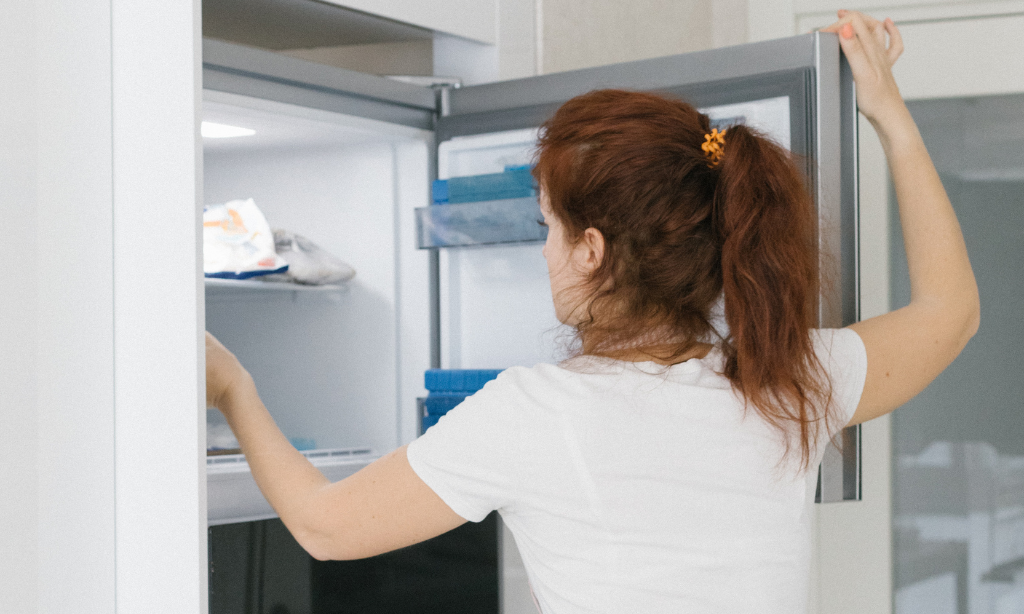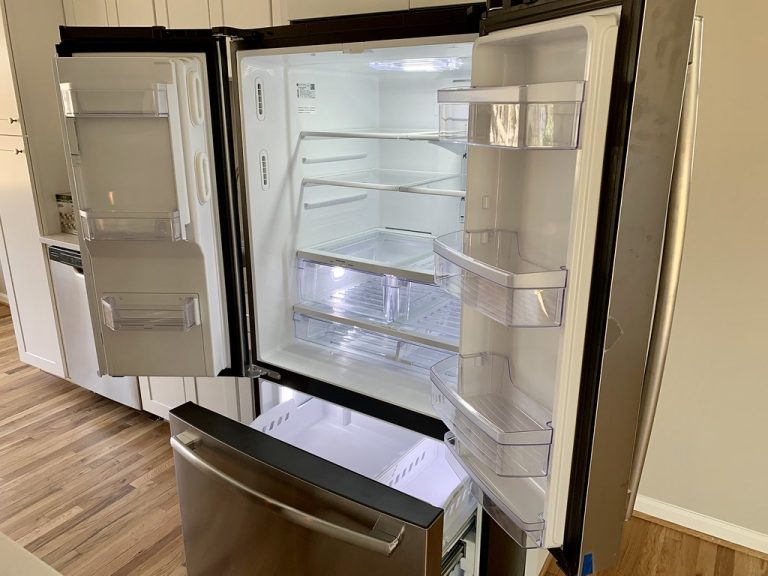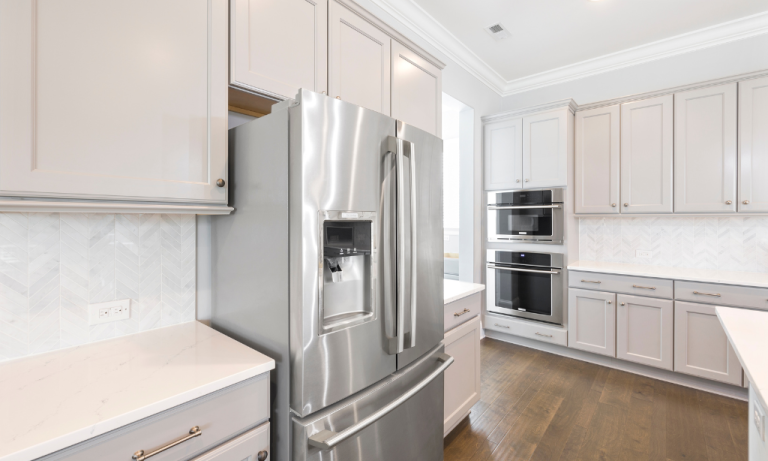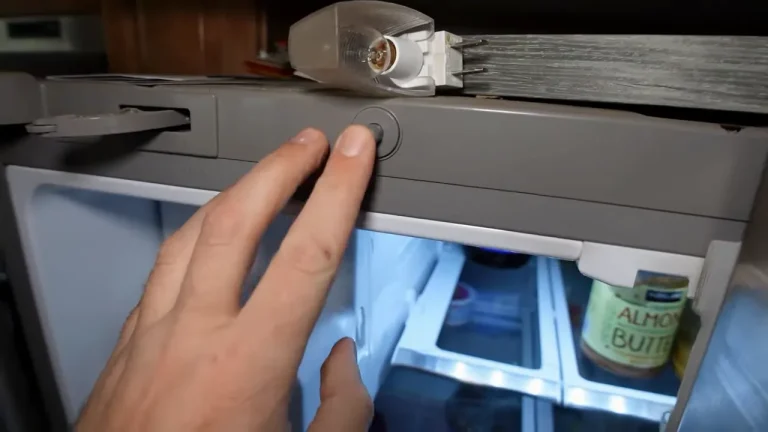Kenmore Elite Refrigerator Troubleshooting Freezer On Bottom [Guide 2024]
The Kenmore Elite Refrigerator with a freezer on the bottom is a popular and efficient appliance choice for many households. However, like any complex electrical appliance, it can experience occasional issues. This guide aims to provide troubleshooting tips for common problems that owners of Kenmore Elite refrigerators with bottom freezers may encounter. By following these steps, you can potentially identify and resolve issues without the need for professional assistance, saving both time and money.
Why Is My Kenmore Bottom Freezer Not Working?
Here are nine reasons your Kenmore Bottom freezer may fail to work and what to do to fix it.
1. Power Disruption
Check Power Connection
Ensure that the refrigerator is securely plugged into a functioning power outlet.
Inspect the power cord for any signs of damage. If you find any, replace it immediately.
Inspect Circuit Breaker
Locate the circuit breaker panel in your home.
Check if the breaker corresponding to the refrigerator’s outlet has tripped. If so, reset it.
Utilize a Surge Protector
Consider using a surge protector to shield your refrigerator from power surges. This can help prevent damage to the appliance during electrical fluctuations.
Test with Another Device
Plug another functioning device (like a lamp or phone charger) into the same outlet to verify if it is receiving power. This will help you determine if the issue is with the outlet itself.
Backup Power Source
If possible, connect your refrigerator to a backup power source, like an uninterruptible power supply (UPS), especially if you reside in an area prone to frequent power outages.
2. Defrost Cycle
The defrost cycle is a crucial function in a refrigerator that prevents ice buildup on the evaporator coils. If this cycle is not functioning properly, it can lead to reduced cooling efficiency.
Possible Fixes:
Manual Defrost
If you suspect the defrost cycle is not working, you can manually defrost the freezer by unplugging the refrigerator and leaving the freezer door open. Allow the ice to melt naturally. This may temporarily resolve the issue.
Check the Defrost Timer
Locate the defrost timer, typically found near the thermostat or at the bottom front of the fridge. It controls the defrost cycle.
Turn the timer dial slowly until you hear a click. This should initiate the defrost cycle. If it doesn’t, the timer may be faulty and needs replacement.
Inspect the Defrost Heater
The defrost heater is responsible for melting frost and ice off the coils. Check if it’s visibly damaged or burnt out. If so, it should be replaced.
Test the Defrost Thermostat
This thermostat is a safety device that prevents overheating during the defrost cycle. Using a multimeter, check for continuity when the thermostat is cold. If there’s no continuity, it needs to be replaced.
Here is a link to Refrigerator with Accela Ice Technology on Amazon. If you want, you can buy it here at the best price.
Defrost Control Board Examination
For more modern refrigerators, there might be an electronic control board that manages the defrost cycle. Check for any visible signs of damage or burnt components. If found, the board may require replacement.
Call a Technician
If you’re unsure about any of the above steps or if the issue persists, it’s recommended to contact a professional technician. They have the expertise to diagnose and fix complex electrical and refrigeration problems.
3. Demo Mode
Some modern refrigerators, including Kenmore models, have a “Demo Mode” or “Showroom Mode” feature. This mode is designed for display purposes in stores, and when activated, it can prevent the refrigerator from cooling properly.
Possible Fixes:
Deactivate Demo Mode
Refer to the user manual that came with your Kenmore refrigerator. It should have specific instructions on how to deactivate Demo Mode. Typically, it involves pressing and holding a combination of buttons for a certain period of time.
Consult the User Manual
If you don’t have the manual, you can often find it online by searching for your specific Kenmore refrigerator model. Look for instructions on how to disable Demo Mode.
Power Cycle the Refrigerator
Unplug the refrigerator from the power outlet and leave it unplugged for about 5-10 minutes. Then, plug it back in and check if it’s now operating normally.
Contact Kenmore Customer Support
If you’re unable to find the solution in the manual or online, consider reaching out to Kenmore’s customer support. They should be able to provide specific instructions based on your model.
Factory Reset
Some refrigerators have a factory reset option that can revert all settings back to their original state. Check your user manual for instructions on how to perform a factory reset.
Professional Assistance
If all else fails, or if you’re uncomfortable with troubleshooting electrical appliances, it’s best to contact a professional technician. They have the expertise to diagnose and fix more complex issues.
Here is a link to Kenmore Top-Freezer Refrigerator with Ice Maker on Amazon. If you want, you can buy it here at the best price.
4. Freezer Overstuffing
Overloading the freezer can lead to inadequate airflow, improper cooling, and potential damage to the contents of the freezer.
Possible Fixes:
Remove Excess Items
Start by taking out any unnecessary or expired items. This creates more space and allows air to circulate properly.
Organize Contents
Arrange items in a way that promotes better airflow. Place larger items at the back and smaller items towards the front. Use baskets or bins to group similar items together.
Leave Room for Air Circulation
Avoid packing items too tightly together. Leave some space around them to allow cold air to circulate freely.
Check the Freezer Fan
Ensure the fan inside the freezer is working properly. It helps circulate cold air. If it’s not functioning, it may need to be replaced.
Inspect the Thermostat Settings
Make sure the thermostat settings are appropriate for the freezer. It’s possible that if it’s set too high, it might not be able to cool the contents effectively.
Defrost the Freezer
If there’s excessive ice buildup, it’s a sign of poor airflow. Unplug the refrigerator and let it thaw completely. Remove any excess ice using a towel.
Check for Damaged Gaskets
The gasket is the rubber seal around the freezer door. If it’s damaged or not sealing properly, warm air can enter the freezer, causing it to overwork. Replace the gasket if needed.
Regular Maintenance
Schedule regular cleanings and defrosting sessions. This prevents ice buildup and ensures the freezer functions optimally.
Consider a Larger Freezer
If you consistently find yourself overstuffing the freezer, it might be worth considering a larger one or using a secondary freezer to distribute the load.
Consult the Manual
Refer to your Kenmore refrigerator’s user manual for specific guidelines on storage capacity and organization.
Here is a link to Top Freezer Refrigerator on Amazon. If you want, you can buy it here at the best price.
5. Door Air Leakage
Air leakage around the refrigerator or freezer door can lead to loss of cool air and increased energy consumption as the appliance works harder to maintain the desired temperature.
Possible Fixes:
Check Door Seal
Inspect the rubber gasket around the door for any signs of damage, wear, or misalignment. A damaged gasket can allow warm air to enter. Clean it regularly to ensure a proper seal.
Clean the Gasket
Use warm, soapy water to clean the gasket. Rinse and dry it thoroughly. Avoid using abrasive cleaners or harsh chemicals, as they can damage the rubber.
Adjust Door Alignment
If the door is not properly aligned, it may not close tightly. Check if it’s level and adjust the hinges if necessary. Refer to the user manual for specific instructions on adjusting the door.
Test the Dollar Bill Trick
Close the door on a dollar bill or a piece of paper. Try to pull it out. If it slips out easily, the gasket may not be sealing properly.
Replace Damaged Gasket
If the gasket is worn, torn, or no longer sealing effectively, it will need to be replaced. Contact the manufacturer or a qualified technician for a replacement gasket.
Check for Obstructions
Ensure there are no items or debris preventing the door from closing properly. Even a small obstruction can lead to air leakage.
Inspect Hinges and Latches
Check if the hinges or latches are loose or damaged. Tighten any loose screws or bolts and replace any damaged components.
Use a Magnetic Strip or Sealant
In cases of minor air leakage, you can use a magnetic strip or a silicone-based sealant around the edges of the door as a temporary solution.
6. Misadjusted Thermostat
An improperly set thermostat can lead to incorrect temperature levels inside the refrigerator or freezer, resulting in either insufficient cooling or excessive freezing.
Possible Fixes:
Check the Thermostat Settings
Make sure the thermostat is set to the correct temperature for both the refrigerator and freezer compartments. Refer to your user manual for recommended settings.
Allow Time for Temperature Stabilization
After adjusting the thermostat, allow some time (usually a few hours) for the appliance to reach the desired temperature. Avoid frequently opening the door during this time.
Use an External Thermometer
Place an external thermometer inside the refrigerator and freezer to monitor the temperature accurately. This can help you confirm if the thermostat settings are correct.
Calibrate the Thermostat
Some modern refrigerators have a calibration feature that allows you to fine-tune the temperature settings. Consult your user manual for instructions on how to calibrate the thermostat.
Avoid Placing Hot Items Inside
Placing hot or warm items in the refrigerator or freezer can cause the thermostat to overcompensate. Allow hot items to cool down before storing them.
Regularly Clean the Condenser Coils
Dirty condenser coils can cause the thermostat to work harder to maintain the desired temperature. Clean them regularly to ensure efficient operation.
Inspect for Obstructions
Make sure there are no items blocking the vents or air circulation pathways. Proper airflow is crucial for maintaining consistent temperatures.
Consult the User Manual
Refer to your Kenmore refrigerator’s user manual for specific information on thermostat adjustment and temperature settings.
7. Frosted Evaporator Coils
Frost buildup on the evaporator coils can reduce the efficiency of your refrigerator, leading to inadequate cooling.
Possible Fixes:
Manual Defrosting
Unplug the refrigerator and leave the freezer door open. Allow the ice to melt naturally. This may temporarily resolve the issue.
Check the Defrost Timer
Locate the defrost timer, typically found near the thermostat or at the bottom front of the fridge. It controls the defrost cycle.
Turn the timer dial slowly until you hear a click. This should initiate the defrost cycle. If it doesn’t, the timer may be faulty and needs replacement.
Inspect the Defrost Heater
The defrost heater is responsible for melting frost and ice off the coils. Check if it’s visibly damaged or burnt out. If so, it should be replaced.
Test the Defrost Thermostat
Using a multimeter, check for continuity when the thermostat is cold. If there’s no continuity, it needs to be replaced.
Clean the Condenser Coils
Dirty condenser coils can hinder the cooling process. Clean them using a brush or vacuum cleaner.
Ensure Proper Air Circulation
Make sure there are no obstructions blocking the vents or air circulation pathways. Proper airflow is crucial for preventing frost buildup.
Adjust the Thermostat Settings
Ensure the thermostat settings are appropriate for the freezer. It’s possible that if it’s set too high, it might not be able to prevent frost buildup.
Check for Gasket Damage
The gasket is the rubber seal around the freezer door. If it’s damaged or not sealing properly, warm air can enter the freezer, causing it to overwork. Replace the gasket if needed.
Consult the User Manual
Refer to your Kenmore refrigerator’s user manual for specific guidelines on defrosting and maintenance.
8. Dirty Condenser Coils
Dirt and debris accumulation on the condenser coils can reduce the refrigerator’s efficiency, leading to inadequate cooling.
Possible Fixes:
Unplug the Refrigerator
Before starting any maintenance, unplug the refrigerator from the power outlet to ensure safety.
Locate the Condenser Coils
Depending on your refrigerator model, the condenser coils can be found either at the back of the refrigerator or at the bottom.
Brush or Vacuum the Coils
Use a soft brush or a vacuum cleaner with a brush attachment to gently clean the coils. Be careful not to damage the coils or any other components.
Remove Stubborn Debris
For stubborn dirt or debris, you can use a coil cleaning brush or a specialized coil cleaning tool to reach tight spaces.
Clean the Surrounding Area
Ensure the area around the coils is also free from dust and debris. This will help maintain proper airflow.
Regular Maintenance Schedule
Establish a routine for cleaning the condenser coils. Aim to do it at least once or twice a year to prevent excessive buildup.
Consider a Condenser Coil Brush
A condenser coil cleaning brush is a specialized tool designed to effectively clean the coils. It can be a good investment for maintaining your refrigerator.
Check for Fan Operation
If your refrigerator has a fan near the condenser coils, make sure it’s working properly. The fan helps in circulating air over the coils for efficient cooling.
Kenmore Elite Bottom Freezer Refrigerator Not Cooling
If your Kenmore Elite bottom freezer refrigerator is not cooling properly, several factors could be contributing to this issue. One common culprit is a malfunctioning thermostat, which regulates the temperature inside the refrigerator and freezer compartments.
If the thermostat is not functioning correctly, it may not signal the cooling system to operate as needed. Additionally, a dirty condenser coil can hinder the refrigerator’s ability to expel heat, leading to reduced cooling efficiency.
Another potential issue could be a malfunctioning compressor, which is responsible for compressing refrigerant gas and circulating it through the system. If the compressor is not working, the refrigerator will not cool properly. It’s also important to check the evaporator fan, which circulates air over the coils, and the condenser fan, which helps dissipate heat.
If either of these fans is not functioning, it can lead to cooling problems. Lastly, a refrigerant leak can cause a drop in cooling capacity. If you’ve checked these common issues and the problem persists, it’s recommended to seek the assistance of a professional technician to diagnose and resolve the specific problem with your Kenmore Elite bottom freezer refrigerator.
Kenmore Elite Refrigerator Temperature Control Not Working
If you’re experiencing issues with the temperature control on your Kenmore Elite refrigerator, it can be frustrating and inconvenient. Several factors may contribute to this problem. One potential cause is a malfunctioning thermostat.
The thermostat is responsible for regulating the temperature inside the refrigerator and freezer compartments. If it’s not functioning correctly, it may not accurately respond to temperature adjustments, leading to inconsistent cooling. Additionally, electronic control boards in modern refrigerators, including Kenmore Elites, can sometimes fail, affecting the temperature settings. This can result in the refrigerator not maintaining the desired temperature.
Another issue might be a faulty temperature sensor, which sends signals to the control board about the current temperature. If this sensor is malfunctioning, it can lead to incorrect temperature readings. It’s also crucial to ensure that the vents and air circulation pathways inside the refrigerator are not blocked, as this can disrupt temperature distribution.
If you’ve checked these common issues and the problem persists, it’s advisable to consult a professional technician. They have the expertise to diagnose and resolve specific issues related to the temperature control system of your Kenmore Elite refrigerator.
FAQ:
Q: Why is my Kenmore Elite refrigerator’s freezer on the bottom not cooling properly?
A: There could be several reasons for this issue. Start by checking the thermostat settings to ensure they are adjusted correctly. Make sure the vents and air circulation pathways in both the freezer and refrigerator compartments are not blocked, as this can hinder proper cooling. Additionally, inspect the condenser coils for dirt and debris, as a dirty coil can reduce cooling efficiency. If the problem persists, it’s recommended to consult a professional technician to diagnose and resolve the specific issue.
Q: What should I do if I notice excessive frost buildup in the freezer of my Kenmore Elite refrigerator?
A: Excessive frost buildup on the freezer’s evaporator coils can indicate a problem with the defrost system. First, try manually defrosting the freezer by unplugging the refrigerator and leaving the freezer door open. If the issue persists, check the defrost timer, heater, and thermostat for any malfunctions. If you’re unable to resolve the issue, it’s best to contact a professional technician for further diagnosis and repair.
Q: My Kenmore Elite refrigerator is making unusual noises. What could be the cause?
A: Unusual noises can be caused by various factors. It’s possible that the evaporator or condenser fan motors are worn or damaged. The compressor may also be struggling, or there could be an issue with the defrost timer. If you notice any unusual sounds, it’s advisable to consult a professional technician for a thorough inspection and necessary repairs.
Q: The lights inside my Kenmore Elite refrigerator are not working. What should I check?
A: If the lights inside the refrigerator are not functioning, start by checking the bulbs to see if they need replacement. If the bulbs are not the issue, inspect the door switch to ensure it’s making proper contact when the door is opened. If both the bulbs and door switch are in working order, it’s possible there may be an electrical issue, and consulting a professional technician is recommended.
Q: How often should I clean the condenser coils on my Kenmore Elite refrigerator with a bottom freezer?
A: It’s advisable to clean the condenser coils at least once or twice a year. Regular cleaning helps maintain the efficiency of the refrigerator’s cooling system. Be sure to unplug the refrigerator before cleaning the coils to ensure safety.
As an Amazon Associate I earn from qualifying purchases.
- Can You Put Clouds Shoes in the Washing Machine? With Tips & Tricks - April 10, 2024
- European Washing Machine vs American – History, Design, Technology - March 27, 2024
- Can You Put Boxing Gloves In The Washing Machine? – Expert Tips - March 25, 2024



![Are Samsung Refrigerators Good [Expert Guide]](https://homeplacetips.com/wp-content/uploads/2024/01/LG-VS-Samsung-Refrigerators-_-How-Do-They-Compare__000176176-768x432.webp)



![GE Cafe Refrigerator Problems [Solved 2024]](https://homeplacetips.com/wp-content/uploads/2023/12/GE-refrigerator-not-cooling_-Check-these-5-things-first_000056819-768x432.webp)